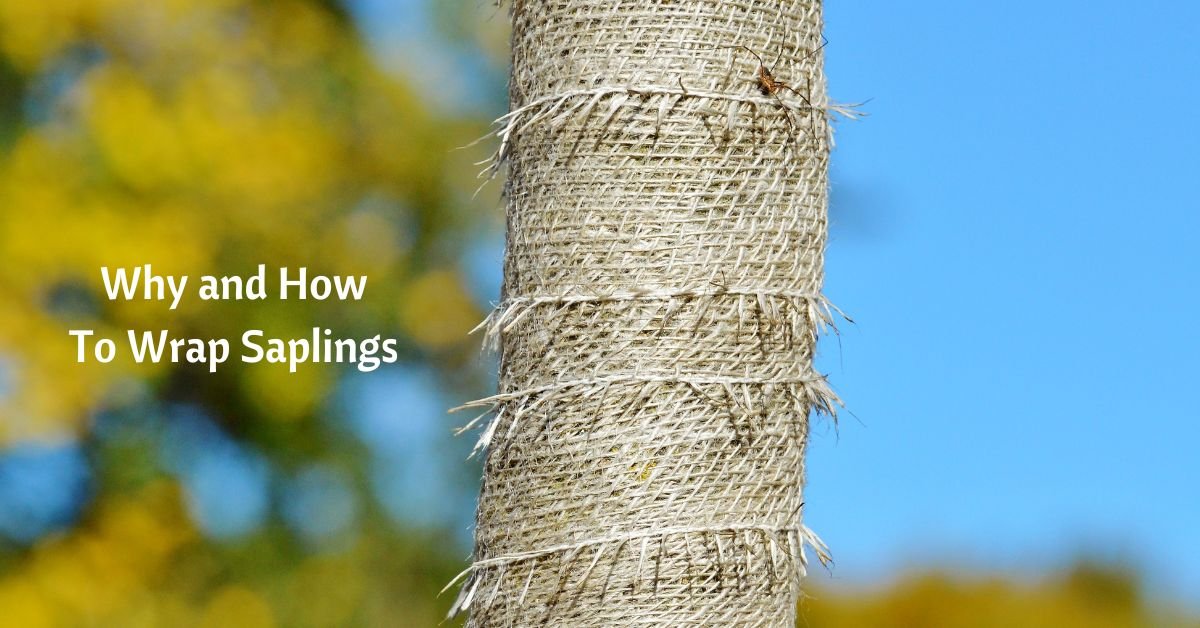Planting saplings can be a long-term investment in your yard’s beauty. It also leads to a healthier environment and can even reduce your heating bills. However, nurturing these young trees requires more than just planting them in the ground and hoping for the best.
One effective method to support their growth is by wrapping saplings. Here, we’ll explore why you should wrap saplings and how to do it.
Benefits of Wrapping Saplings
There are many benefits you can gain from wrapping your saplings. Here are some of the main advantages you can achieve:
Increased Survival Rates
Saplings face numerous challenges during their early years, and wrapping provides a layer of defense against potential threats. This increased protection can significantly boost the survival rates of young trees.
Accelerated Growth
By creating an optimal microenvironment, wrapping encourages faster and healthier growth. The insulation provided by the wrapping helps saplings focus on upward growth rather than expending energy to combat external stressors.
Minimized Transplant Shock
Transplanted saplings face the shock of being moved from one location to another. Wrapping mitigates transplant shock by providing a stable and protective environment, allowing the tree to acclimate more smoothly.
Cost-Effective Long-Term Care
Wrapping entails an initial cost, but the long-term benefits in terms of increased growth and survival rates outweigh this expense. It’s a cost-effective strategy for ensuring the health and longevity of your saplings.
Materials for Wrapping Trees
Choosing the right materials for wrapping is crucial to the success of this practice. Commonly used materials include burlap, tree wrap fabric, or specialized tree wraps available at garden supply stores.
These materials are chosen for their ability to provide insulation, protection, and breathability. Always opt for materials that allow air circulation while offering a barrier against external elements.
How to Wrap Trees
Wrapping saplings requires a little bit of attention. These steps will help you get the best results.
Measure and Cut
Cut the wrapping material into manageable lengths, ensuring it’s long enough to encircle the tree trunk comfortably. You don’t have to use a single piece to cover the whole trunk as long as you overlap the sections.
Start from the Bottom
Begin wrapping the material around the base of the sapling, making sure to overlap each layer slightly. YOu can get the best results if you overlap about ⅓ of each layer. Starting from the bottom and working your way up ensures proper coverage and stability.
Tightness Matters
Secure the wrapping material but avoid wrapping it too tightly. A snug fit is sufficient to protect without risking damage to the tree’s bark. Ensure there is room for some expansion as the tree grows.
Secure the Ends
Once you reach the desired height – normally a little below the first branches – secure the wrapping material in place. This can be done with twine, clips, or any secure fastening method that won’t damage the tree.
Check Regularly
Regularly inspect the wrapping to ensure it remains secure and hasn’t become too tight. Adjust it when needed to accommodate the tree’s growth so that the tree doesn’t experience “girdling,” or misshapement where it can’t develop normally.
How Wrapping Young Trees Pays Off
Wrapping saplings serves multiple purposes, all to provide needed protection and support during their early stages of growth. Here are the most important reasons to consider this practice:
Protection from Wildlife and Mechanical Damage
Saplings are particularly vulnerable to nibbling by wildlife, such as deer, rabbits, or rodents. Also, accidental damage from lawnmowers and other mechanical equipment poses a significant threat while the trees are still small and delicate. Wrapping saplings acts as a physical barrier, safeguarding them from these potential dangers.
Temperature Regulation
Young trees are sensitive to extreme temperature fluctuations, especially during the winter months. Wrapping provides insulation and shields saplings from harsh winds and frost. This protective layer helps maintain a more stable temperature around the sapling. And this can promote healthier growth.
Herbicide and Pesticide Protection
Landscaping practices sometimes require the use of herbicides or pesticides, but saplings may suffer adverse effects if exposed to these chemicals. Wrapping acts as a shield, preventing direct contact with harmful substances and minimizing the risk of damage.
Enhanced Growth Conditions
Wrapping can create a microenvironment around the sapling that promotes optimal growth conditions. It can help retain moisture, regulate humidity, and protect against sudden weather changes, fostering a conducive environment for healthy development.
When to Wrap Saplings?
Timing is crucial when it comes to wrapping saplings. While the practice can be beneficial, it should be done at the right stage of the tree’s development. Here’s a breakdown of when wrapping is most effective:
Early Spring or Fall Planting
If you’ve planted saplings in early spring or late fall, wrapping them shortly after planting is advisable. This ensures immediate protection from potential frost and wildlife damage during the vulnerable early stages.
First Year of Growth
Wrapping is particularly beneficial during the first year of a sapling’s growth. This is when the tree is establishing its root system and is most susceptible to environmental stressors. Protecting during this crucial period can significantly impact its long-term health.
Before Winter Sets In
In regions with harsh winters, wrapping saplings before the onset of winter is essential. This protects them from freezing temperatures, frost, and potential damage caused by heavy snowfall.
Drawbacks and Considerations
While wrapping saplings has numerous advantages, it’s important to consider potential drawbacks and limitations:
Risk of Disease and Pests
In certain cases, wrapping may create a sheltered environment that attracts pests or encourages the growth of specific diseases. Regular monitoring and adjustments to the wrapping are necessary to mitigate this risk.
Improper Installation
If not installed correctly, wrapping can have detrimental effects. Tying the material too tightly or using materials that don’t allow for proper air circulation may lead to mold growth or girdling, where the wrapping damages the tree’s bark.
Overreliance on Wrapping
Wrapping is beneficial but it doesn’t replace other essential care practices such as proper watering, fertilization, and pruning. Overreliance on wrapping without addressing other aspects of tree care may result in suboptimal growth.
Wrapping Up the Green Investment
Wrapping young trees is a valuable practice that contributes to the overall health and vitality of young trees. By providing protection against external threats, regulating temperature, and creating an optimal growth environment, wrapping sets the stage for a robust and flourishing tree. With the right care and attention, wrapping saplings becomes a green investment in the future and improves both the appearance and usefulness of your yard.









